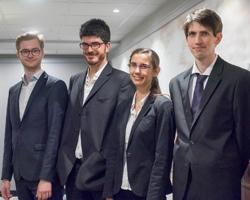
Toulouse les Orgues Festival announces winners of its Xavier Darasse Organ Competition, the final round of which was October 7, 2017.
First prize was awarded to two competitors, Giulio Tosti and Hendrik Burkhard. Second prize was awarded also to two competitors, Johannes Skoog and Muriel Groz. The audience prize was presented to Muriel Groz. This is the first time the competition has designated two winners and two second-place competitors.
The jury consisted of Michel Bouvard, Benoît Mernier, Jan Willem Jansen, Lorenzo Ghielmi, Louis Robilliard, Juan de la Rubia, and Wolfgang Zerer.
For information: www.toulouse-les-orgues.org.
Pictured: Johannes Skoog, Giulio Tosti, Muriel Groz, and Hendrik Burkhard (photo credit: Thomas Guilin)

